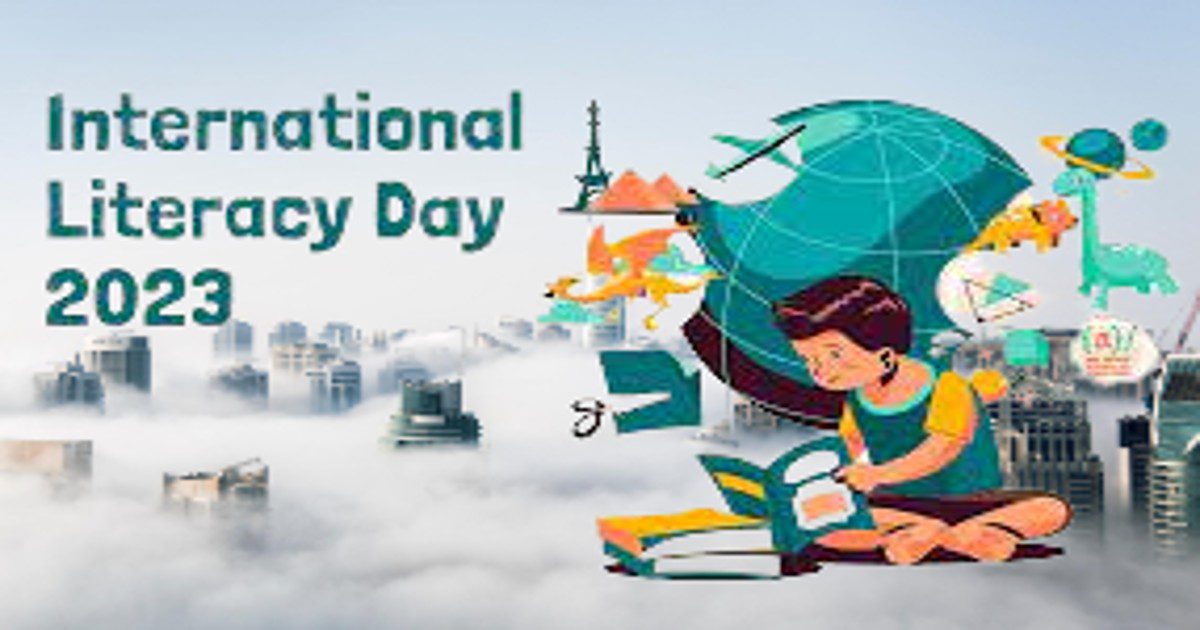World Literacy Day: Since 1967, International Literacy Day (ILD) or World Literacy Day celebrations have taken place annually on 8th September around the world to remind the public of the importance of literacy as a matter of dignity and human rights, and to advance the literacy agenda towards a more literate and sustainable society.
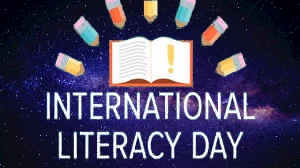
World Literacy Day
International Literacy Day is an international observance, celebrated each year on 8 September, that was declared by UNESCO on 26 October 1966 at the 14th session of UNESCO’s General Conference. International Literacy Day was celebrated for the first time in 1967.
Although much progress has been made in improving literacy rates in the more than fifty years since the first International Literacy Day, illiteracy remains a global problem. There are thought to be more than 750 million adults around the world who cannot read. The scourge of Illiteracy spares no nation or culture on earth, including the United States, where an estimated 32 million American adults are illiterate.
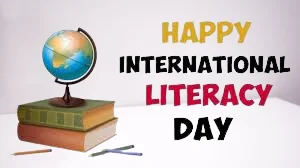
What exactly is literacy? Miriam-Webster Dictionary defines literacy as “the quality or state of being literate: educated…able to read and write.”
International Literacy Day was first conceived at the “World Conference of Ministers of Education on the Eradication of Illiteracy” held in Tehran, Iran in 1965. The following year UNESCO took the lead and declared September 8 as International Literacy Day, with the primary purpose being “…to remind the international community of the importance of literacy for individuals, communities and societies, and the need for intensified efforts towards more literate societies.” One year later, the global community accepted the challenge of ending illiteracy by participating in the first International Literacy Day.
International Literacy Day 2023
UNESCO, in collaboration with its Member States and partners, will celebrate International Literacy Day (ILD) on 8 September 2023 under the theme of “Promoting literacy for a world in transition: Building the foundation for sustainable and peaceful societies”.
Literacy Rate by Country 2023
Literacy—the ability to read and write—is arguably the single most important factor in determining a person’s career arc. For those who can read and write, the range of possible vocations is vast—even highly skilled, high-paying careers are within reach. For those who cannot, the options are extremely limited—even unskilled minimum-wage jobs can be difficult to obtain.
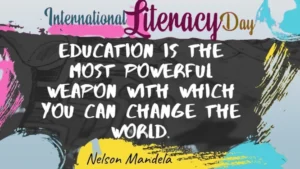
As a whole, the global literacy rate is high. The literacy rate for all males and females that are at least 15 years old is 86.3%. Males aged 15 and over have a literacy rate of 90%, while females lag only slightly behind at 82.7%. However, massive country-to-country differences exist. Developed nations almost always have an adult literacy rate of 96% or better. In contrast, the least developed nations manage an average literacy rate of only 65%. Direct country-to-country comparisons of literacy tend to be inexact. This is due mainly to two confounding factors: Many countries do not report their literacy every year, and many countries have mismatched definitions as to what qualifies as literacy.
Literacy rate by country
| Country | Latest Rate | Rate Year | 2023 Population |
| Finland | 100% | 2000 | 5,545,475 |
| Norway | 100% | 2011 | 5,474,360 |
| Luxembourg | 100% | 2000 | 654,768 |
| Andorra | 100% | 2011 | 80,088 |
| Greenland | 100% | 2001 | 56,643 |
| Liechtenstein | 100% | 2011 | 39,584 |
| Uzbekistan | 100% | 2015 | 35,163,944 |
| Latvia | 99.89% | 2015 | 1,830,211 |
| Estonia | 99.82% | 2015 | 1,322,765 |
| Lithuania | 99.82% | 2015 | 2,718,352 |
| Azerbaijan | 99.81% | 2015 | 10,412,651 |
| Guam | 99.79% | 2015 | 172,952 |
| Kazakhstan | 99.79% | 2015 | 19,606,633 |
| Poland | 99.79% | 2015 | 41,026,067 |
| Tajikistan | 99.78% | 2015 | 10,143,543 |
| Armenia | 99.77% | 2015 | 2,777,970 |
| Ukraine | 99.76% | 2015 | 36,744,634 |
| Georgia | 99.76% | 2015 | 3,728,282 |
| Belarus | 99.72% | 2015 | 9,498,238 |
| Russia | 99.72% | 2015 | 144,444,359 |
| Slovenia | 99.71% | 2015 | 2,119,675 |
| Cuba | 99.71% | 2015 | 11,194,449 |
| Barbados | 99.70% | 2002 | 281,995 |
| Turkmenistan | 99.69% | 2015 | 6,516,100 |
| Slovakia | 99.60% | 2004 | 5,795,199 |
| Palau | 99.52% | 2015 | 18,058 |
| Kyrgyzstan | 99.50% | 2015 | 6,735,347 |
| Tonga | 99.40% | 2015 | 107,773 |
| Hungary | 99.38% | 2015 | 10,156,239 |
| Maldives | 99.32% | 2015 | 521,021 |
| Croatia | 99.27% | 2015 | 4,008,617 |
| Moldova | 99.24% | 2015 | 3,435,931 |
| Cyprus | 99.06% | 2015 | 1,260,138 |
| Italy | 99.02% | 2015 | 58,870,762 |
| Samoa | 99.02% | 2015 | 225,681 |
| United States | 99% | 2003 | 339,996,563 |
| Japan | 99% | 2002 | 123,294,513 |
| Germany | 99% | 2003 | 83,294,633 |
| United Kingdom | 99% | 2003 | 67,736,802 |
| France | 99% | 2003 | 64,756,584 |
| Canada | 99% | 2003 | 38,781,291 |
| Australia | 99% | 2003 | 26,439,111 |
| Netherlands | 99% | 2003 | 17,618,299 |
| Belgium | 99% | 2003 | 11,686,140 |
| Sweden | 99% | 2003 | 10,612,086 |
| Switzerland | 99% | 2003 | 8,796,669 |
| Denmark | 99% | 2003 | 5,910,913 |
| New Zealand | 99% | 2003 | 5,228,100 |
| Ireland | 99% | 2003 | 5,056,935 |
| Iceland | 99% | 2003 | 375,318 |
| Monaco | 99% | 2003 | 36,297 |
| Saint Pierre And Miquelon | 99% | 1982 | 5,840 |
| Trinidad And Tobago | 98.97% | 2015 | 1,534,937 |
| Antigua And Barbuda | 98.95% | 2014 | 94,298 |
| Cayman Islands | 98.87% | 2007 | 69,310 |
| Romania | 98.76% | 2015 | 19,892,812 |
| Montenegro | 98.72% | 2015 | 626,485 |
| Bosnia And Herzegovina | 98.49% | 2015 | 3,210,847 |
| Uruguay | 98.44% | 2015 | 3,423,108 |
| Bulgaria | 98.39% | 2015 | 6,687,717 |
| Mongolia | 98.37% | 2015 | 3,447,157 |
| Marshall Islands | 98.27% | 2015 | 41,996 |
| Spain | 98.11% | 2015 | 47,519,628 |
| Argentina | 98.09% | 2015 | 45,773,884 |
| Jordan | 98.01% | 2015 | 11,337,052 |
| Serbia | 98% | 2015 | 7,149,077 |
| Austria | 98% | 2011 | 8,958,960 |
| French Polynesia | 98% | 1977 | 308,872 |
| Bermuda | 98% | 2005 | 64,069 |
| Turks And Caicos Islands | 98% | 1970 | 46,062 |
| South Korea | 97.97% | 2008 | 51,784,059 |
| North Macedonia | 97.84% | 2015 | 2,085,679 |
| Saint Kitts And Nevis | 97.80% | 2003 | 47,755 |
| British Virgin Islands | 97.80% | 1991 | 31,538 |
| Qatar | 97.76% | 2015 | 2,716,391 |
| Costa Rica | 97.65% | 2015 | 5,212,173 |
| Albania | 97.55% | 2015 | 2,832,439 |
| Aruba | 97.52% | 2015 | 106,277 |
| American Samoa | 97.34% | 1980 | 43,914 |
| Israel | 97.10% | 2004 | 9,174,520 |
| Northern Mariana Islands | 97% | 1980 | 49,796 |
| Montserrat | 97% | 1970 | 4,386 |
| New Caledonia | 96.94% | 2015 | 292,991 |
| Singapore | 96.77% | 2015 | 6,014,723 |
| Palestine | 96.67% | 2015 | 5,371,230 |
| Brunei | 96.66% | 2015 | 452,524 |
| Chile | 96.63% | 2015 | 19,629,590 |
| Philippines | 96.62% | 2015 | 117,337,368 |
| China | 96.36% | 2015 | 1,425,671,352 |
| Kuwait | 96.12% | 2015 | 4,310,108 |
| Taiwan | 96.10% | 2003 | 23,923,276 |
| Grenada | 96% | 2003 | 126,183 |
| San Marino | 96% | 2011 | 33,642 |
| Bahrain | 95.72% | 2015 | 1,485,509 |
| Turkey | 95.69% | 2015 | 85,816,199 |
| Saint Vincent And The Grenadines | 95.63% | 1970 | 103,698 |
| Bahamas | 95.60% | 2003 | 412,623 |
| Suriname | 95.54% | 2015 | 623,236 |
| Paraguay | 95.54% | 2015 | 6,861,524 |
| Indonesia | 95.44% | 2015 | 277,534,122 |
| Portugal | 95.43% | 2015 | 10,247,605 |
| Venezuela | 95.40% | 2015 | 28,838,499 |
| Seychelles | 95.32% | 2015 | 107,660 |
| Greece | 95.29% | 2015 | 10,341,277 |
| Equatorial Guinea | 95.20% | 2015 | 1,714,671 |
| Bolivia | 95.14% | 2015 | 12,388,571 |
| Panama | 95.04% | 2015 | 4,468,087 |
| Cook Islands | 95% | 2011 | 17,044 |
| Anguilla | 95% | 1984 | 15,899 |
| Niue | 95% | 2011 | 1,935 |
| Saudi Arabia | 94.84% | 2015 | 36,947,025 |
| Malaysia | 94.64% | 2015 | 34,308,525 |
| South Africa | 94.60% | 2015 | 60,414,495 |
| Colombia | 94.58% | 2015 | 52,085,168 |
| Mexico | 94.55% | 2015 | 128,455,567 |
| Ecuador | 94.52% | 2015 | 18,190,484 |
| Vietnam | 94.51% | 2015 | 98,858,950 |
| Peru | 94.37% | 2015 | 34,352,719 |
| Malta | 94.07% | 2015 | 535,064 |
| Lebanon | 94.05% | 2015 | 5,353,930 |
| Dominica | 94% | 2003 | 73,040 |
| Thailand | 93.98% | 2015 | 71,801,279 |
| Oman | 93.97% | 2015 | 4,644,384 |
| Fiji | 93.70% | 2003 | 936,375 |
| Hong Kong | 93.50% | 2002 | 7,491,609 |
| Puerto Rico | 93.33% | 2015 | 3,260,314 |
| Myanmar | 93.09% | 2015 | 54,577,997 |
| United Arab Emirates | 92.99% | 2015 | 9,516,871 |
| Sri Lanka | 92.61% | 2015 | 21,893,579 |
| Brazil | 92.59% | 2015 | 216,422,446 |
| Dominican Republic | 92.47% | 2015 | 11,332,972 |
| Sao Tome And Principe | 91.75% | 2015 | 231,856 |
| Libya | 91.39% | 2015 | 6,888,388 |
| Namibia | 90.82% | 2015 | 2,604,172 |
| Mauritius | 90.62% | 2015 | 1,300,557 |
| Saint Lucia | 90.10% | 2001 | 180,251 |
| Micronesia | 89% | 1980 | 115,224 |
| Jamaica | 88.50% | 2015 | 2,825,544 |
| Cape Verde | 88.47% | 2015 | 598,682 |
| Honduras | 88.42% | 2015 | 10,593,798 |
| Botswana | 88.22% | 2015 | 2,675,352 |
| El Salvador | 87.65% | 2015 | 6,364,943 |
| Guyana | 87.54% | 2015 | 813,834 |
| Eswatini | 87.47% | 2015 | 1,210,822 |
| Iran | 87.17% | 2015 | 89,172,767 |
| Zimbabwe | 86.87% | 2015 | 16,665,409 |
| Syria | 86.30% | 2015 | 23,227,014 |
| Burundi | 85.50% | 2015 | 13,238,559 |
| Zambia | 85.12% | 2015 | 20,569,737 |
| Vanuatu | 85.06% | 2015 | 334,506 |
| Solomon Islands | 84.10% | 2011 | 740,424 |
| Gabon | 83.24% | 2015 | 2,436,566 |
| Belize | 82.78% | 2015 | 410,825 |
| Nicaragua | 82.47% | 2015 | 7,046,310 |
| Tunisia | 81.05% | 2015 | 12,458,223 |
| Tanzania | 80.36% | 2015 | 67,438,106 |
| Gibraltar | 80% | 2011 | 32,688 |
| Laos | 79.87% | 2015 | 7,633,779 |
| Iraq | 79.72% | 2015 | 45,504,560 |
| Algeria | 79.61% | 2015 | 45,606,480 |
| Lesotho | 79.36% | 2015 | 2,330,318 |
| Guatemala | 79.07% | 2015 | 18,092,026 |
| Cambodia | 78.35% | 2015 | 16,944,826 |
| Comoros | 78.14% | 2015 | 852,075 |
| Kenya | 78.02% | 2015 | 55,100,586 |
| Dr Congo | 77.22% | 2015 | 102,262,808 |
| Ghana | 76.58% | 2015 | 34,121,985 |
| Egypt | 75.84% | 2015 | 112,716,598 |
| Cameroon | 74.99% | 2015 | 28,647,293 |
| Eritrea | 73.85% | 2015 | 3,748,901 |
| Uganda | 73.81% | 2015 | 48,582,334 |
| India | 72.23% | 2015 | 1,428,627,663 |
| Morocco | 71.71% | 2015 | 37,840,044 |
| Rwanda | 71.24% | 2015 | 14,094,683 |
| Angola | 71.16% | 2015 | 36,684,202 |
| Yemen | 69.96% | 2015 | 34,449,825 |
| Djibouti | 67.90% | 2003 | 1,136,455 |
| Togo | 66.54% | 2015 | 9,053,799 |
| Malawi | 65.96% | 2015 | 20,931,751 |
| Nepal | 64.66% | 2015 | 30,896,590 |
| Madagascar | 64.66% | 2015 | 30,325,732 |
| Bhutan | 63.91% | 2015 | 787,424 |
| Papua New Guinea | 63.43% | 2015 | 10,329,931 |
| Bangladesh | 61.49% | 2015 | 172,954,319 |
| Haiti | 60.69% | 2015 | 11,724,763 |
| Guinea Bissau | 59.77% | 2015 | 2,150,842 |
| Nigeria | 59.57% | 2015 | 223,804,632 |
| Mozambique | 58.84% | 2015 | 33,897,354 |
| Sudan | 58.60% | 2015 | 48,109,006 |
| Pakistan | 56.44% | 2015 | 240,485,658 |
| Senegal | 55.62% | 2015 | 17,763,163 |
| Gambia | 55.57% | 2015 | 2,773,168 |
| Mauritania | 52.12% | 2015 | 4,862,989 |
| Wallis And Futuna | 50% | 1969 | 11,502 |
| Ethiopia | 49.03% | 2015 | 126,527,060 |
| Sierra Leone | 48.43% | 2015 | 8,791,092 |
| Liberia | 47.60% | 2015 | 5,418,377 |
| Ivory Coast | 43.27% | 2015 | 28,873,034 |
| Chad | 40.02% | 2015 | 18,278,568 |
| Benin | 38.45% | 2015 | 13,712,828 |
| Afghanistan | 38.17% | 2015 | 42,239,854 |
| Somalia | 37.80% | 2001 | 18,143,378 |
| Burkina Faso | 37.75% | 2015 | 23,251,485 |
| Central African Republic | 36.75% | 2015 | 5,742,315 |
| Mali | 33.07% | 2015 | 23,293,698 |
| South Sudan | 31.98% | 2015 | 11,088,796 |
| Guinea | 30.47% | 2015 | 14,190,612 |
| Niger | 19.10% | 2015 | 27,202,843 |
Literacy Rate – India
Literacy is a powerful tool to improve the lives of people. It helps them to overcome the struggles of poverty. And empowers them to prosper independently. The benefits of education and literacy are widely discussed topics. But in India, we are still struggling to make our population 100% literate.
Some figures about literacy:
India’s total literacy rate is 77.70% (2021 and 2022). And this weightage is achieved after a very long period of reforms and policies.
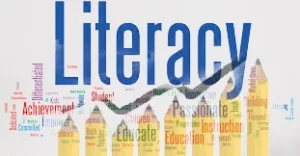
In the year 1947 when India got its independence, the literacy rate was dismal. Only 18% of the overall population was literate. And the same weightage was even worse for females (only 8.86%). From this percentage to the current literacy rate, India has covered a huge gap with a network of traditional and online schools. India’s literacy rate state wise has increased considerably. And the weightage of the female literate population has also improved substantially.
The National Family Health Survey (NFHS) provided details on many aspects related to family planning, health, nutrition, etc. through multi-round surveys in India.
Let’s begin by taking a look at some of the top findings (demographic and socioeconomic characteristics) of the survey respondents.
- The literacy rate of men was reported as 84%.
- For women, this rate was 72%.
- 41% of women and 32% of men were not exposed to mass media.
- 75% of men and 25% of women are employed
- 46% of women and 32% of men were employed as agricultural workers.
- 11% of women and 9% of men were employed in the private sector.
Top 10 Most literate States in India
- Kerala
- Delhi
- Chandigarh
- Himanchal Pradesh
- Maharashtra
- Tamil Nadu
- Uttarakhand
- Gujrat
- West Bengal
- Punjab
Indian Literacy Rate 2023
The literacy rate of Indian women has grown over the years. According to the World Bank India report, only 1 of 11 girls was literate at the time of India’s independence, about nine percent. And at present, the women’s literacy rate has jumped to 77% while India’s male literacy rate stands at 84.7%.
As per the government’s National Sample Survey report as on March 2023, Kerala is the most literate state in the country with 94%, followed by union territory Lakshadweep (91.85%). The third-most literate state in the country is Mizoram (91.33%). Whereas Bihar has the lowest literacy rate in India at 61.8%, followed by Arunachal Pradesh at 65.3% and Rajasthan at 66.1%.
However, around 12.6% of students drop out of school in India, and 19.8% discontinued education at the secondary level.
The number is significantly higher for girls as they get married early and in many communities educating girls is not even a priority and is seen as an unnecessary cost. Globally, 1.8 million girls get married underage.
In India, the literacy rate, including the female literacy rate is abysmally low in rural areas and in some pockets of urban areas. The literacy rate in rural India is 67.77% as compared to 84.11% in urban India.
Literacy rate also called the “effective literacy rate“; the total percentage of the population of an area at a particular time aged seven years or above who can read and write with understanding. Here the denominator is the population aged seven years or more.
Effective literacy rate=number of literate persons aged 7 or above multiplied by total population aged 7 and above×100
Hope you liked the article on “World literacy Day”/ “International Literacy Day”. Share your feedback by visiting the comment section. Follow read4knowledge for more articles from the general awareness section.
